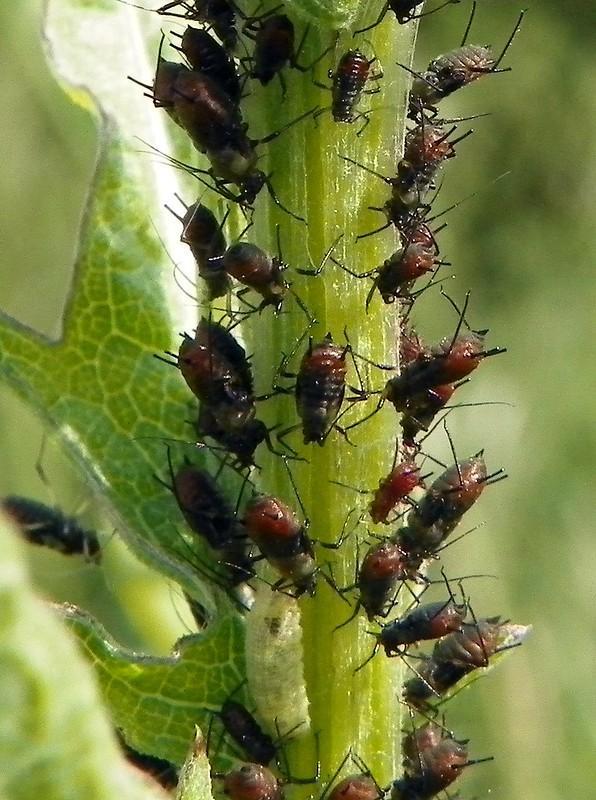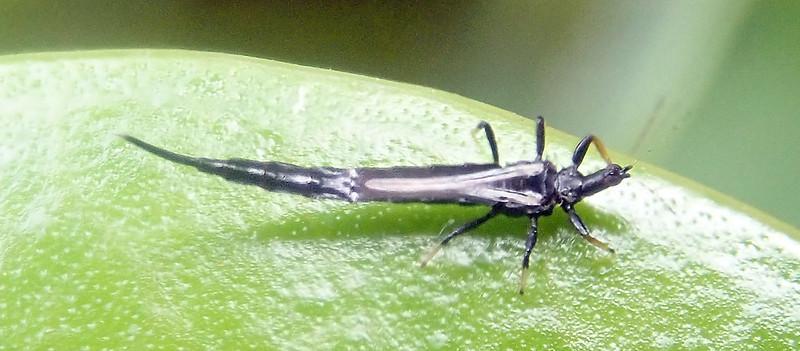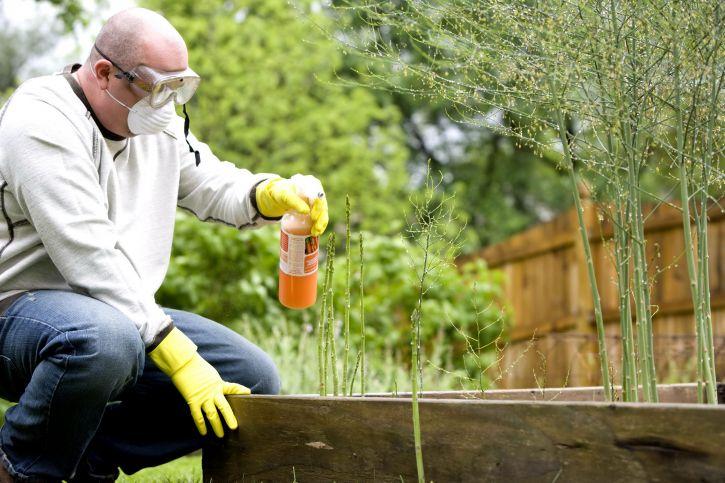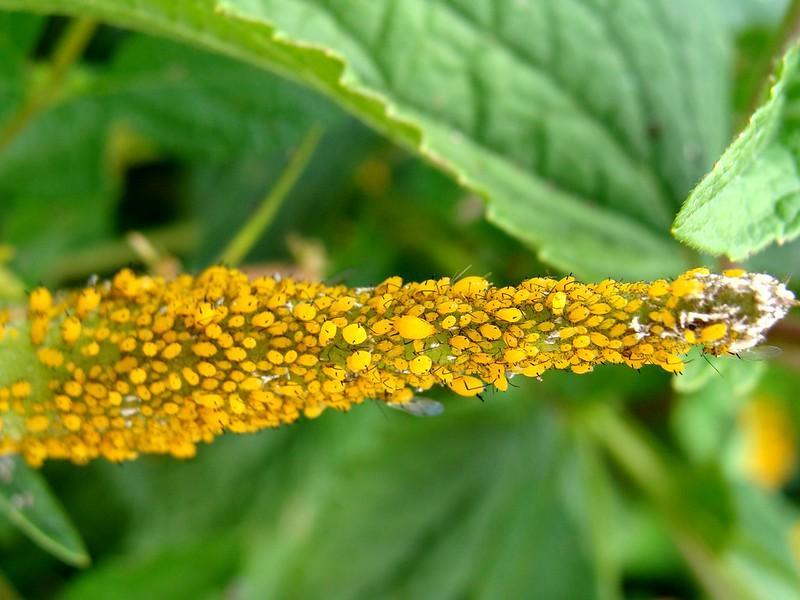If you have been gardening for some time, you have probably seen both aphids and thrips at some point. Both these creatures are typical problems in backyard gardens and greenhouses. They are most likely to harm your plants near the end of the spring season when the temperature begins to increase. Therefore, every gardener has to deal with them once a year. But how can you tell them apart, and which of them causes more damage to your plants? Well, that is what this article is about. So, continue reading to find out, aphids vs thrips whats worse?

Both Aphids and Thrips can destroy your garden if not dealt with quickly and effectively.
Aphids are egg-shaped insects that range in size from around 2 to 4 millimeters and feed on the sap of your plants, depriving them of the nutrients they need to thrive. You’ll find them clustered together in big groups, often known as colonies, on the stems and leaves of plants.
On the other hand, thrips are very small insects with wings that measure between 1/25 and 1/50 of an inch. Thrips will feed on the foliage of your plants, causing damage or even killing the plants.
Both aphids and thrips can wreck your garden if not treated on time. They can also transfer viruses through their saliva and cause other diseases in your plants. The result is stunted growth of the plant and dropping leaves.
So, if you want to save your plants from these nasty pests, read on!
How To Identify Aphids And Aphid-Infested Plants?

Aphid damage is shown by distorted, curled, or yellowing leaves. Aphids love to hide under leaves, so look there.
Aphids are little, squishy insects whose mouthparts are adapted for penetrating and extracting sap from plants. They are most likely to be found on food crops or the young, fragile development of plants. Their length is usually somewhere between 1/16 and 1/8 of an inch on average (2-4mm). These pests tend to congregate in great numbers, or colonies, on the tender stems and leaves of the plant they have affected.
There are two different ways in which aphids can harm plants. They feed on the sap and secrete a sticky honeydew that draws ants and other insects. Infested plants will exhibit symptoms such as yellowing leaves, poor growth, and malformed blooms and fruit. Aphid infestation is also indicated by the presence of sticky fluid (honeydew) on the leaves and stems.
This honeydew is what draws in other insects like ants to the plants. Therefore, if you see ants foraging on a plant, it is pretty likely that the plant is afflicted with aphids, and you should look for them on the stems and under the leaves of the plant, where they love to hide.
Related: How To Get Rid Of Thrips On Orchids For Good? The Ultimate Guide
How To Identify Thrips And Thrips-Infested Plants?

Plants with thrips damage have streaks, silvery speckling, and little white spots.
Thrips are tiny (approximately 1/50-1/25 of an inch) pests with stubby wings. Even though they have wings, they are weak fliers. You can find them in a wide variety of colors, ranging from yellow to dark brownish black. Because of their small size and camouflaging hue, you won’t notice them until they’ve caused significant harm to the plants.
Thrips are most likely to be seen on ornamental plants and vegetable crops. Their feeding may not be enough to kill the plant outright, but it can slow its development. Due to their feeding, white spots and several silvery dots appear on the injured leaves.
Fruits that are still developing can be malformed or damaged by thrips, including apples, nectarines, and raspberries. Citrus thrips reduce blueberry yield by severely distorting the plant’s stem tips and leaves.
Thrips, on their own, do not cause much harm to the plant, but they can transmit many viruses. These include, for instance, the tomato spotted wilt virus and the necrotic spot virus. Certain vegetable crops are susceptible to viruses that can cause severe damage or even cause death.
How To Get Rid Of Aphids?

The safest and fastest approach to removing aphids is to spray them with a garden hose.
Since aphids primarily infest vegetable crops and attractive plants, you should never use chemicals to control aphids. Chemicals can leave toxins on vegetables and, in the case of ornamental plants, will hurt beneficial insects and kill the lovely butterflies in your garden. Aphids should, thus, be managed through the use of natural and organic techniques. To eliminate aphids from your garden, try the following method.
Use Water Pressure To Remove Aphids
Aphids on plants can be easily removed by spraying them with water under high pressure. This is the first thing you should do when dealing with aphids in your garden or house plants.
However, take care not to apply excessive pressure since this could cause the delicate leaves and branches to break. If you want to get rid of all the aphids on your plant, you’ll need to keep doing this for a few days.
Related: Aphids on Indoor Houseplants: 10+ Smart Ways to Get Rid of Them!
Homemade Aphid Spray To Get Rid Of Aphids
Even if you remove the aphids from your plants by washing them, there is no guarantee that they won’t return. Utilizing a DIY aphid spray is a great way to beef up your defenses against these pesky insects.
In a spray bottle, combine two or three tablespoons of dishwashing liquid with water, and you should be set to go. Target the aphids directly with the spray on your plant. It will eliminate the aphids and prevent the eggs from hatching into new insects.
Biological Control For Aphids
It is time to further strengthen the defensive system after you have taken immediate steps 1 and 2 to get rid of the aphids and stop the damage they are causing. Aphids are easy prey for ladybugs and lacewings, which are both great predators and voracious eaters.
You can purchase these insects for your garden online or find ways to attract them to your garden naturally. Planting herbs like mint, dandelions, fennel, and yarrow in your garden will bring in beneficial insects that help keep pest populations under control.
Aphids are their primary food source. Therefore, the presence of these beneficial insects will help keep aphid populations in check.
How To Prevent Aphids From Coming Back?
Last but not least, safeguard your garden from further aphid infestations. In order to guarantee this, we recommend the following aphid-prevention strategies:
- Be sure you are not giving an excellent breeding environment for the aphids by leaving litter on the ground. If you do this, you will attract more aphids. So, don’t let piles of dead leaves accumulate in your garden; keep everything neat and tidy.
- Aphids can be deterred from plants by using natural deterrents such as garlic, onions, and chives. If you have any of these plants in your garden, you won’t have to worry much about aphids.
- Aphids might be enticed away from your plants if you have enough room in your garden. Plants such as dahlias, asters, and nasturtiums should be grown in a separate area from the garden. Since the aphids will be focused on these particular plants, the remainder of the garden will be spared their infestation.
How To Get Rid Of Thrips?

To get rid of thrips, remove grass and weeds from the vicinity of garden areas.
Some gardeners have said that thrips are impossible to eradicate. This is not the case at all. If you adhere to the procedures that we have outlined for you, you will be able to get rid of thrips once and for all and stop them from returning in the future.
Once again., try your best to only use organic and natural means of thrips management. Thrips have strong immune systems, so If you use chemicals on thrips, they will quickly develop resistance to the chemicals, which will make your situation even worse.
Keeping this in mind, here is a list of methods that can be utilized to get rid of thrips.
Isolating The Infected Plant
Isolating the diseased plant should be your first order of business to prevent the thrips from infecting other otherwise healthy plants. Also, inspect all the plants thoroughly, paying particular attention to the undersides of the leaves, which is where thrips are most likely to be hiding. Remove and isolate any infected plants you may discover.
Washing Your Plants To Get Rid Of Thrips
The second thing you should do is wash the plant that has been infected. Thrips are very little parasites that feed on plants and can be removed using water pressure. Create some pressure with a water hose, and while you’re at it, ensure the undersides of the leaves, which are where the thrips are hiding, are also sprayed.
Related: What are the Best Practices to Get Rid of Thrips on Houseplants?
Neem Oil Spray
Neem oil spray is a great, all-natural, organic pesticide. Making your own neem oil spray at home is a pretty simple process. To produce neem oil spray, combine three teaspoons of neem oil and two teaspoons of dishwashing soap in one gallon of water.
Your neem oil spray is now ready. This oil should be sprayed directly over the lesions and the afflicted portions of the plant. Neem oil can kill nymphs, and when applied to adults, it causes a loss of appetite, which results in the insect’s death from starvation.
How To Prevent Thrips From Coming Back?
Making sure that the thrips do not return is the very last step in the process. You can accomplish so in various ways, and the following are some suggestions for you.
- Maintain a clean garden and pick up any dead leaves that have fallen to the ground. During the winter months, thrips will lay their eggs in decomposing leaves.
- The thrips parasite thrives on the weeds. One such example is cannabis. Weeds growing on the vineyard floor, in particular, attract a lot of thrips. Therefore, you should make it a habit to frequently eradicate the weeds from your yard.
- Be careful not to saturate your plants with water. Thrips are most common in environments that are humid and moist. Also, try to water your plants first thing in the morning so that they are dry by the time you come back to them at night.
Conclusion
Aphids and thrips are both common garden pests and unwanted plant companions. They thrive in damp, dark environments and can be spotted munching on plant parts. Also, they have economic value to plants since they make early pruning easier.
However, they must be managed, or else the plants and even the soil around them would suffer damage because of their presence.
Frequently Asked Questions (FAQs)
Are aphids the same as thrips?
Aphids are not the same as thrips. Thrips can accumulate in weedy regions and other nearby crops, and as the host plants start to dry up, they can move in huge numbers to lettuce and other plants. On the other hand, aphid colonies sip sap from succulent stems and the undersides of leaves, while slender, winged thrips prefer fragile leaves and flower buds.
Can you get rid of thrips?
If you want to get rid of thrips, you should get rid of the weeds and grass around your gardens. Additionally, spray the leaves of outside plants with water from the hose to eliminate thrips. Concentrate on the underside of the leaves, where they congregate. Pruning and removing any damaged plant parts can help you get rid of thrips.
What is the difference between aphids and mites?
Fortunately, numerous techniques distinguish between spider mites and aphids, both of which can harm or even kill your plants. Aphids are tiny, oblong insects that feed on the sap of delicate plant tissues. On the other hand, Spider mites are recognized by the silk webbing they form on afflicted leaves. They are so tiny that a magnifying glass is required to see them clearly.
How do I get rid of aphids and thrips?
Aphids and thrips can be eradicated from outdoor and indoor plants with the help of an insecticidal soap that is both nontoxic and ready to use. Insecticidal soap spray causes suffocation in the insects that it comes into contact with. You should direct the spray at the undersides of the leaves, the stems, the leaf and flower buds, and the tips of the shoots.
Can plants recover from thrips?
The full recovery of plants from thrips can take several months, although it is possible. Thrips feeding can impede plant growth and result in injured leaves being papery and deformed, developing tiny pale patches (stippling), and falling off early. After an infection has been eradicated, your plant needs regular maintenance so that it can recover.
How do you know if a plant has aphids?
Aphids are nearly always found on the leaves of the plants you have in your home. They’re small but not so small that they can’t be seen with the naked eye. Keep an eye out for shriveled, curled, stunted, or yellowing leaves. It is essential to check the undersides of the leaves, as this is a common hiding spot for aphids.
Where do thrips hide?
Thrips are masters of hide-and-seek, particularly hiding. The bug retreats to protected areas, cracks, plant debris, or the ground during the winter. They can be discovered on the leaves and bark of trees. On other plants, it will be in the flower blossoms, on the stalks, or the leaves.
Sources For Further Reading
Aphids, Mites, and Thrips – Gardening Solutions – University of Florida, Institute of Food and Agricultural Sciences. (2022). Retrieved 14 September 2022, from https://gardeningsolutions.ifas.ufl.edu/care/pests-and-diseases/pests/thrips.html
Aphids, scales, thrips, et cetera – Pests of home, garden, landscape, and turf – UC Statewide IPM Program. (2022). Retrieved 14 September 2022, from http://ipm.ucanr.edu/PMG/invertebrates/menu.aphidsthrips.html
Management of Aphids and Thrips on Leafy Vegetables (ACIS). (2022). Retrieved 14 September 2022, from https://cals.arizona.edu/crop/vegetables/insects/aphid/aphidsandthrips.html
Aphids, spider mites, thrips — oh, my! Heat and dryness wilt vegetables but creates bumper crop of insect pests | Cornell Chronicle. (2005). Retrieved 14 September 2022, from https://news.cornell.edu/stories/2005/08/summer-heat-produces-insect-pests
Editor’s Recommendations
Fungus Gnats vs. Fruit Flies: How to Get Rid of Them on Houseplants?
How to Kill Whiteflies on Houseplants? Plus Organic & Inorganic Methods
Common Types of Houseplant Bugs: Who They are & How to Get Rid of Them?







